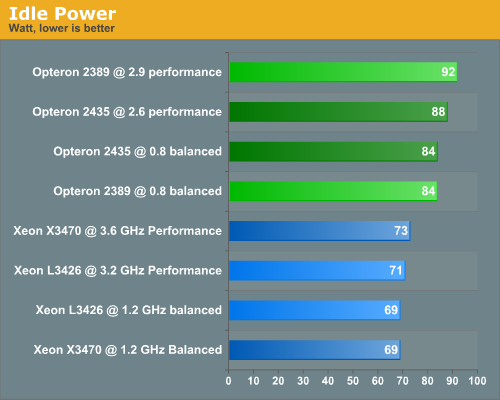Dynamic Power Management: A Quantitative Approach
by Johan De Gelas on January 18, 2010 2:00 AM EST- Posted in
- IT Computing
Our Benchmark Choice
For this article we chose Fritzmark 4.2, the chess benchmark designed by Mathias Feist. The benchmark has the disadvantage that it is not real world for most IT professionals, but it allows us to control the number of threads very easily and precisely. It is also a completely integer dominated benchmark which runs completely in the CPU caches. This allows us to isolate the CPU power savings and the performance and power measurements will still have some resemblance to the typical server loads. This is in contrast to an FP intensive benchmark like LINPACK.
Software Power Management: Windows 2008 Power Plans
On our 64-bit Windows Server 2008 R2 Enterprise two power plans are available:

The interesting thing is how the power plan affects the processor power management (PPM). With Balanced, Turbo Boost never came into action. The L3426 was stuck at 1.86GHz and the X3470 never clocked higher than 2.93GHz. When running idle, both CPUs stayed at 1.2GHz (9x multiplier). The Opterons scaled back to 0.8GHz.
Once set at the Performance power plan, the CPUs never scaled below the default clock speed. According to most clock speed utilities, the Xeons always tried to achieve the highest possible Turbo Boost clock speed. The L3426 switched between 3.066 and 3.2GHz. Note that this did not increase the power consumption significantly: it only used 2W extra on the L3426. The Opterons ran at their top speed. To measure the effect of the power plans we measured the power consumption of the different servers running idle in Windows 2008 R2. This is the power consumption of the complete system, measured at the electrical outlet minus the fans.

We focus on a comparison between the green and blue bars. Comparing the CPUs on each platform offers some interesting insights. Let's first check out the AMD Platform. The Opteron 2389 "Shanghai" clearly needs a higher voltage to achieve 2.9GHz (1.15 - 1.325 V). Despite the fact that the six-core has two cores more to power, the six-core Opteron needs 4W less than the 2.9GHz quad-core Opteron. The reason is that the 2.6GHz never needs more than 1.3V (min: 1.075V) and is also making very good use of clock gating with cache dump (a.k.a. "Smart Fetch").
The idle power measurement of the Xeons shows us how little power is saved by scaling back the frequency: only 2W. The power savings are a result of fine-grained clock gating and core power gating.










35 Comments
View All Comments
UrQuan3 - Thursday, January 21, 2010 - link
I'm trying to remember for 2008, but wasn't there a way to either force or suggest thread/core affinity? It looks like the scheduler was hopping all over the place on the Opterons.JarredWalton - Thursday, January 21, 2010 - link
You guys better pay attention and answer this post, or his species will try to enslave and/or wipe out the entire galaxy! ;-)mino - Wednesday, January 20, 2010 - link
I mean, not, why do you use them for this article.They are fine examples of low-power platforms, even if from vastly different markets.
But,
WHY ON EARTH DO YOU KEEP TALKING LIKE THEY WERE COMPARABLE THROUGHOUT THE ARTICLE ???
IntelUser2000 - Wednesday, January 20, 2010 - link
By the way, I don't know if you have the settings wrong or that's how it works, the Turbo Boost mode is not affected on the Home PC versions of Windows. Balanced uses Turbo Boost just as well on my Windows 7 Home Premium with Core i5 661.JarredWalton - Wednesday, January 20, 2010 - link
I was wondering this as well, but I'm not familiar with Windows Server... what I do know is that Power Saver on consumer Windows OSes really limits the CPU frequency scaling features, and it sort of looks like Balanced on the Server OS has aspects of consumer "Power Saver" as well as some elements of "Balanced". Odd to see only two power settings available, where Win7 now has at least 3 and often 5.mino - Wednesday, January 20, 2010 - link
It seems a classic example of KISS strategy of choosing the most-sensible options and so reducing decision complexity for IT people.Modes like "Max battery" have anyway no reason for existence on a server box.
RobinBee - Tuesday, January 19, 2010 - link
If you use your pc as a music server:Power saving methods ruin sound quality even if using a good sound card. The problem is »electronic« sound distortion. I do not know why this happens.
Also: The chosen number of IRQ pr. second in a net card can ruin sound quality too. Why, I do not know.
Anato - Tuesday, January 19, 2010 - link
I'm interested to see results from different operating systems which may be better at controlling processes in different CPU's. Namely no CPU hopping and is their power management as efficient as Windows is.Most interested at:
Linux and Solaris
JohanAnandtech - Tuesday, January 19, 2010 - link
Excellent suggestion :-). Problem is to keep the application the same. We currently tested SQL Server 2008 on Windows 2008 and of course this can not be done on Linux. However, I am not stranger to linux as a server.I am no fan of MySQL on Windows, but maybe this has improved. Would MySQL on Windows and Linux makes sense as a comparison?
maveric7911 - Tuesday, January 19, 2010 - link
Why not use oracle ;)